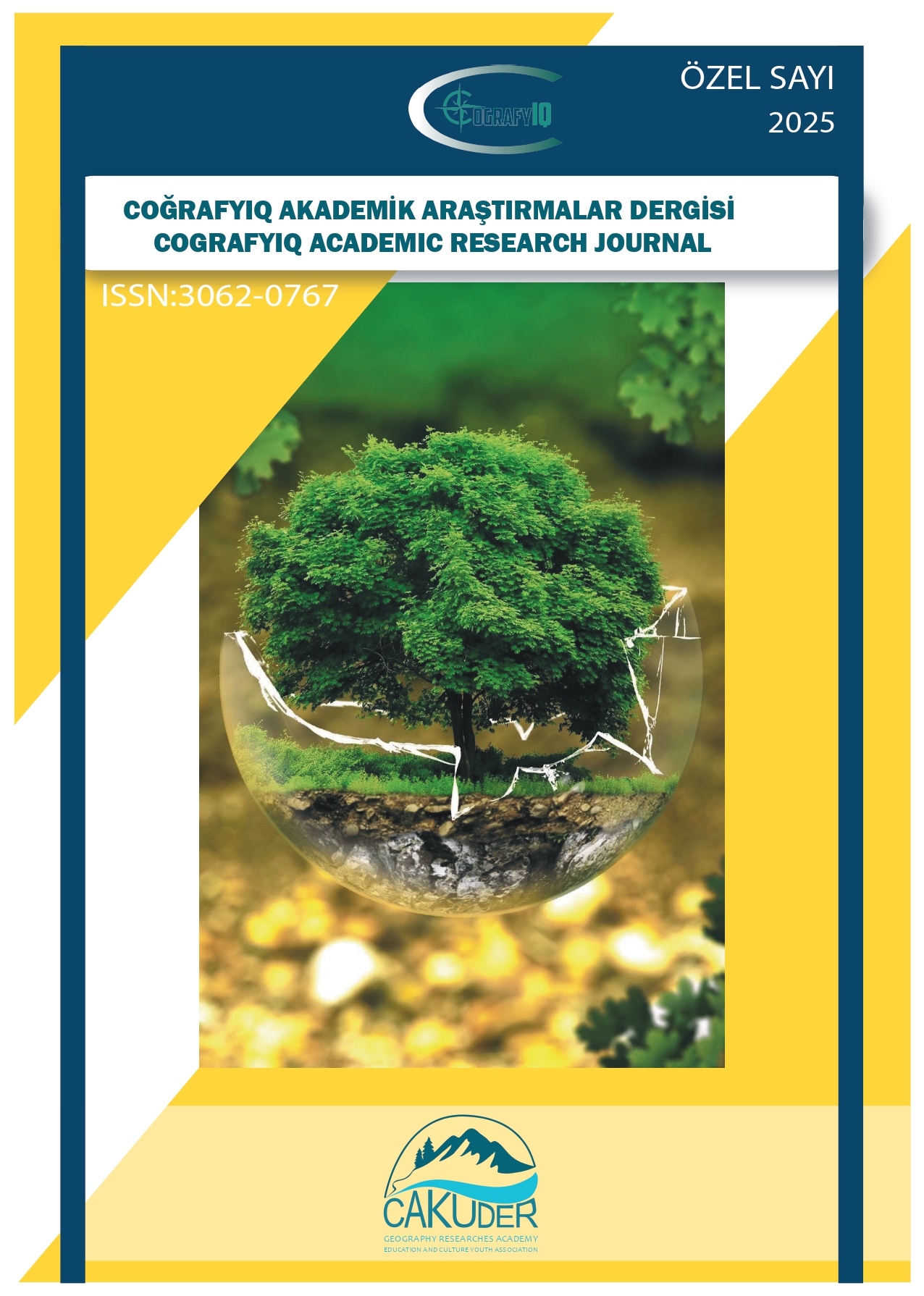Proposal for a Methodological Approach to Cultural Geomorphology Studies .
DOI:
https://doi.org/10.5281/zenodo.14620217Keywords:
Air Pollution, Geoparks, Cultural GeomorphositeAbstract
In the last two centuries, people have had an increasingly important impact on the material transfer and changing landforms on the earth, primarily through agricultural activities, mining and quarrying, and the construction of cities and roads. The research methodology to be used in cultural geomorphology studies was established with the study and a study technique discussed in four sections was determined. Within the scope of the recommendations, a mixed research method was used in the study. The geographical characteristics of the research area were obtained using the quantitative research method. The data were subjected to meta-analysis and the definition of the area was made. With the progressive and regressive research method study, land observation and evaluation were made, the existence and needs of cultural areas were revealed. Using the qualitative research technique, the theory of the concept of cultural geomorphology was developed, hypotheses were created, interpretations and generalizations were made.
References
Baylak, H.M. ve Erkal, T. In critique of history, concepts and approaches on “why should we make geoparks?. American Research Journal of Humanities & Social Science, 3(12): 06-22/ 2020.
Baylak, H.M. Cultural Geomorphology of Kilistra (Gökyurt) Region, Konya. Çankırı Karatekin University, Institute of Social Sciences, 2023.
Brandolini, P., Cappadonia, C., Luberti, G.M., Donadia, C., Stamatopoulos, L., Maggio, D.C., Faccini, F., Stanislao, C., Vergari, F., Paliaga, G., Agnesi, V., Alevizos, G. and Monte, D.M. “Geomorphology of the anthropocene in Mediterranean Urban Areas”. Progress in Physical Geography (SAGE), 1:34/2019.
Brown, A.G., Tooth, S. and Bullard, J.F. The geomorphology of the anthropocene: Emergence, status and ımplications. Earth Surface Processes and Land-forms, 42:71-90/2017.
Brunsden, D. A critical assessment of the sensitivity concept in geomorphology. Catena, 42: 99-123/2001.
Cooke, R.U. Urban geomorphology. The Geographical Journal, 142 (1):59-65/1976.
Coper, A.H., Brown, T.J. and Price, S.J. Humans are the most significont global geomorphogical driving force of the 21 st century. The Anthropocene Review, 5(3): 222-229/2018.
Crutzen, P.J. Geology of mankind. Nature, 415: 23/2002.
Erkal, A. (2018). Anthropogeomorphological studies in Körfez District (Kocaeli). Bilecik Seyh Edebali University, Institute of Social Sciences, Department of Geography, Unpublished Master's Thesis, (Bilecik:2018).
Goudie, A.S. The human impact on the environment. 6th edn. Blackwel,Oxford 10 J. (England:2007).
Hale, G.A. The origin, nature and distribution of agricultural terracing. Pacific View Point, 2:1-40/1961.
Ibisch PL, Hoffman MT, Kreft S, Pe’er G, Kai V, Biber-Fredenberger L, DellaSala DA, Vale MM, Hobson PR, and Selva N. A global map of roadless areas and their conservation status. Science, 354(6318): 1423–1427/2016.
Knight, J. and Harrison, S. A land history of men: The ıntersection of geomorphology, culture and heritage in Cornwall, Southwest England. Applied Geography, 42: 186-194/2013.
Lu, X.X. Spatial variability and temporal change of eater discharge and sediment flux in the Lower Jinsha Tributary: Impact of environment changes. River Research and Applications, 21 (2-3): 229-243/2005.
Mostafaei, S. and Moshiri, S.R. Human culture and how it can be affected by geomorphology. UJRSET, 2(3): 148-152/2013.
Panizza, M. and Piacente, S. Geomorphology and cultural heritage in coastal environments. Geogr. Fis. Dinam. Quat., 31 (5): 205-210/2008.
Panizza, M. and Piacente, S. (2009). Cultural geomorphology and geodiversity. In: Reynard, E., Coratza, P., Regolini-Bissig, G. (Eds.), Geomorphosites. Pfeil Verlag, Munchen, pp. 35-48.
Shakouie, H. Philosophy of geography. Gitashenasi Publication, (Tahran:1995).
Sherlock, R.L. Man as Geological Agent. nSpencer,JE. (Witherby, London:1922).
Szabo, J. A Tarsadalom Hatasa a Földfelszinre (Social in pact on the Earth’s surface). In: Borsy, Z. (ed.). A Halanos Termeszetföldrajz (Physical Geography);500-518. (Budapest:1993).
Uzun, M. Anthropogenic Geomorphology in Dilderesi Basin (Gebze-Dilovası): Changes, dimensions and effects”. International Journal of Geography and Geography Education (IGGE), 41: 319-345/2020.
Vitousek, P. M, Erlich, P.R, Erlich, A.H. and Mason, P.A. Human appropriations of the products of photosynthesis. BioScience, 36: 368–373/1986.
Wimbledon, W.A.P. National site election, a stop on the road to a european geosite list. Geologica Balcanica, 26: 15-27/1996.
Winemiller, K.O. Balancing hydropower and biodiversity in the Amazon, Congo, and mekong: basin-scale planning is needed to minimize impacts in mega-diverse rivers”. Science, 351: 128–129/2016.
Zalasiewicz, J., Water, C.N. and Williams, M. The anthropocene as a geological time unit. Cambridge University Press, pp. 382/2019.
Downloads
Published
How to Cite
Issue
Section
License
Copyright (c) 2025 Dr.Halil Mesut Baylak, Tevfik ERKAL

This work is licensed under a Creative Commons Attribution 4.0 International License.



